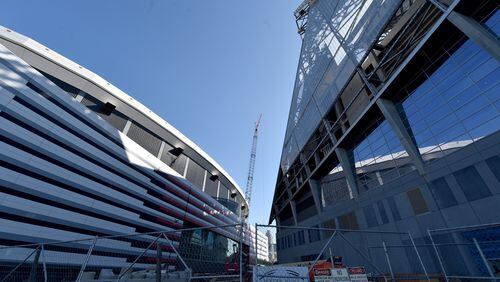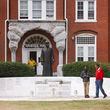Molly Read Woo has been trying to save the Georgia Dome for years, convinced we’re throwing away an economic gem.
We are. But her current grass-roots campaign isn’t going so well.
At a recent press gathering, Atlanta Mayor Kasim Reed told it straight to the frequent community activist when she asked if the city would be willing to take over the venue. The Dome is “going to be imploded and it’s going to be carried away,” he replied.
A "Save the Dome" petition Woo launched online a couple years ago is only half way to her goal of 1,000 signatures. (She planned to deliver it to Gov. Nathan Deal's office anyway.)
Dan Graveline, the former executive director of the Georgia World Congress Center, told me that operating the old stadium beside the Atlanta Falcons' new Mercedes-Benz Stadium would be an expensive financial drain. "Anyone who knows anything about the venue business would tell you that is just not economically viable."
Demolition is expected this summer. The Atlanta city council didn’t bite on Woo’s suggestion that it seek an injunction to stop it.
Woos' windmill-tilting taps into a broader gut feeling that throwing away a perfectly good publicly-owned venue seems horribly wasteful. Even if it seems inevitable, with Arthur Blank's brighter, fresher, cooler retractable-roof Mercedes-Benz Stadium nearing completion next door.
It doesn't always happen this way. The city found a way to keep Turner Field alive after the Atlanta Braves bolted to Cobb. The Ted will be used for Georgia State University football games, with a mixed-use project and other university uses planned around it. And rather than creating another home for the Atlanta Hawks, the mayor agreed the city should pay for the bulk of a millennials-focused $192.5 million renovation of Philips Arena.
The GWCC’s deal with the Falcons mandates that the Dome “will be available for demolition” and that much of the wiped-clean 16-acre site will become parking and space for other Falcons planned uses (expected to be community events on a grassy field). The GWCC also is contemplating a hotel on a piece of the site.
Unwelcome competitor
I suspect the Falcons wouldn’t want the Dome surviving as competition.
One stadium apparently is a city treasure. Two’s a crowd.
I talked to people last weekend attending the Dome's final event – the high-flying truck acrobatics of the Monster Jam. Most expressed exasperation, dismay, puzzlement or disdain over killing a venue that seems, well, like it just came out of the box.
Even GWCC officials use words like “great” to describe the Dome. Who smashes “great”?
Somebody who has their own vision of what they want.
Boosted by $200 million in public funding, Blank aims to create an impressive $1.5-billion Atlanta landmark and get way more control of revenue than he had at the Dome. In addition to the Falcons, the Home Depot co-founder will bring in his new Atlanta United soccer team and, I'm sure, have first dibs on lots of other top events. The College Football Playoff Championship game is set for next year, followed by the Super Bowl in 2019 and the NCAA Men's Final Four in 2020.
The 25-year-old Dome Blank is vacating isn’t beautiful or charming. It’s just a really big building that meets the lofty requirements of being functional.
That’s not enough to spark street marches in its defense.
Hasn’t the train already left the station on this one? I asked Woo.
“If you know a train is going to crash, all the more reason to chase after it and put the brakes on,” she said.
The Dome could host all kinds of events, she told me. Movies, graduations, community sports, Shakespearean plays, multi-day concerts. Maybe the city could sell naming rights, she said.
Time for long-shots
Woo is not an arena expert. She told me she’s worked at some small news publications locally, taught English in Japan for a while, started a short-lived newspaper about the international community in Atlanta. At 55 she doesn’t have a full-time paying job. She’s got time and an inclination for long-shots. She held vigils outside Friendship Baptist Church before it was torn down to make way for the new stadium.
The GWCC pointed out in an email to me that it had experts analyze the two-stadium option early on, but “could not identify any viable financial options for a two-stadium solution that did not put the public’s interests at risk now and well into the future.”
Graveline, the former GWCC chief, helped shepherd the Dome into existence in 1992. (His daugther, who was a young girl when the project started, use to call it “Daddy’s Dome.”)
“I never thought I’d have a chance to build an NFL stadium and still be alive when they took it down,” he told me.
Keeping it in place isn’t much of an option, Graveline said. “All of the major events would go to the new stadium.”
Maybe the Dome would get an occasional concert, but organizers of events with smaller crowds might not find the cavernous space appealing, he said.
“If you don’t draw very well, it’s embarrassing. You are like a rock in a tin can, rattling around.”
Meanwhile, expenses could be tens of millions of dollars a year, including a 100-person full time staff and a bigger group of part-timers.
A giant closet?
Others have been down that road.
The Pontiac Silverdome languished unused for years after the Detroit Lions left it. Local officials are contemplating the chances of having it demolished and turned into some kind of mixed-use project.
The historic Houston Astrodome, which is more than twice as old as the Georgia Dome, last hosted a pro sports team nearly 20 years ago. It held on later with rodeos and other uses. (It sheltered Hurricane Katrina refugees.) But by 2009 it was no longer safe for public use. The county now plans to spend more than $100 million to set it up for festivals, events and indoor parking.
Most recently it was used for storage when the Super Bowl was played nearby in NRG Stadium.
Atlanta doesn’t need to keep the Georgia Dome around as a giant closet.
What we do need, though, is to find better ways to avoid trashing a perfectly good publicly owned stadium next time.
“I would hope,” Graveline said, “at some point we’ve gotten them good enough where you don’t have to tear down a $1.5 billion stadium every 25 years.”
Find Matt on Facebook (https://www.facebook.com/mattkempnercolumnist) and Twitter (@MattKempner) or email him at mkempner@ajc.com.
Other Kempner's Unofficial Business columns: http://www.myajc.com/news/opinion/matt-kempner-unofficial-business/j9F7R2mOGomS5FMjfhho2O/







